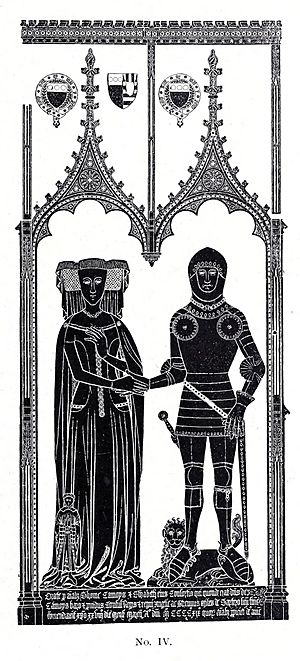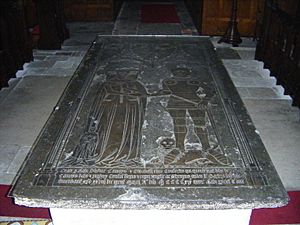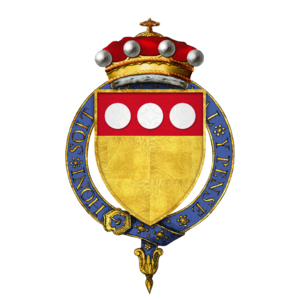Thomas Camoys, 1st Baron Camoys facts for kids
Thomas de Camoys (born around 1351, died March 28, 1421) was an important English nobleman. He came from Trotton in Sussex. Thomas de Camoys is famous for leading part of the English army. He commanded the left side at the big Battle of Agincourt in 1415. He was also a Knight of the Garter, a special honor.
Contents
Who Was Thomas de Camoys?
Thomas de Camoys was the son of Sir John Camoys. His mother was Elizabeth le Latimer. Her father was William le Latimer, a powerful baron. Thomas's grandfather was Ralph de Camoys. His grandmother was Elizabeth le Despenser. Her father was Hugh le Despenser, a very important earl.
His Life and Work
Thomas de Camoys became a baron, which is a noble title. He was called to join the English Parliament many times. This happened from 1383 until 1421. He was the first Baron Camoys of this new title. The earlier title had ended when his uncle, Thomas de Camoys, passed away.
In 1380, Thomas de Camoys went on a trip to France. He was with his cousin, William Latimer. During this trip, he was made a knight. This honor was given to him by Thomas of Woodstock. Later, in 1385, he served in an army trip to Scotland.
Thomas de Camoys did not get much support from King Richard II. But after Richard II was removed from power in 1399, things changed. Thomas attended the first Parliament of the new king, Henry IV. His son, Sir Richard Camoys, was made a knight by King Henry IV. This happened at the king's coronation. Thomas himself helped bring Henry's new queen, Joan of Navarre, to England. This was in 1403. Because he was loyal to King Henry IV, he received many special gifts and lands.
Before King Henry V went to France, Thomas de Camoys was at a meeting. This meeting was to plan the invasion. In 1415, he played a key role in the Battle of Agincourt. He led the back part of the English army's left side. Because of his great service, he was given a special award. He was made a Knight of the Garter in 1416. This is one of the highest honors in England.
His Family
Thomas de Camoys was married two times.
His first wife was Elizabeth Louches. She was the daughter of William Louches. They had children together:
- Sir Richard Camoys: He was Thomas's oldest son. He died before his father. Richard had children of his own:
- Hugh de Camoys, 2nd Baron Camoys: He became the next Baron Camoys after his grandfather.
- Margaret de Camoys: She married Ralph Radmylde.
- Alianora de Camoys: She married Sir Roger Lewknor.
- Alice Camoys: She married Sir Leonard Hastings.
His second wife was Elizabeth Mortimer. She was the widow of a famous knight, Henry Percy, also known as "Hotspur." Elizabeth was the daughter of Edmund Mortimer. Her mother was Philippa, who was a granddaughter of King Edward III. Thomas and Elizabeth had one son:
- Sir Roger Camoys.
His Lands and Homes
Thomas de Camoys received many lands when his uncle died. These included large estates in Trotton, Broadwater, and Elsted in Sussex. He also owned several lands in Northamptonshire.
Through his first marriage to Elizabeth Louches, he gained more property. He inherited a manor in Chiselhampton, Oxfordshire. A fortified house on this land is still known as Camoys Court today.
His Death and Memorial
Thomas de Camoys passed away on March 28, 1421. However, the year on his tomb is wrong. It says 1419. His grandson, Hugh de Camoys, 2nd Baron Camoys, became the next baron.
His tomb is still in St George's Church, Trotton. It is a large stone chest in the middle of the church. On top of it is a metal plate, called a monumental brass. This brass shows Thomas and his second wife, Elizabeth Mortimer. They are holding hands. The brass is very big and detailed. It is considered one of the best preserved in England.
The words on the brass are in Latin. They say: "Pray for the souls of Thomas Camoys and his wife Elizabeth. He was once Lord Camoys, a baron and a wise advisor to the King and the kingdom of England. He was also a brave Knight of the Garter. He gave his life to Christ on the 28th day of March in the year of our Lord 1419 (this year is wrong). May God be kind to their souls. Amen."





